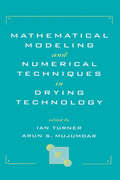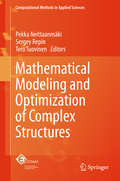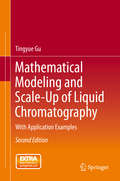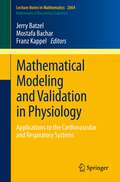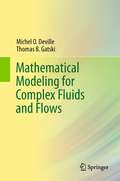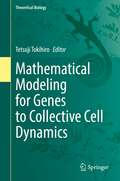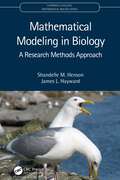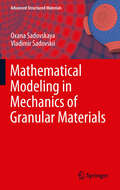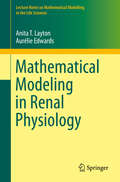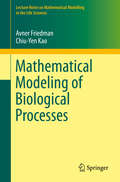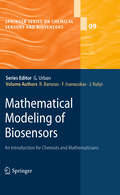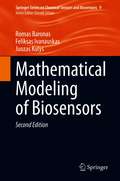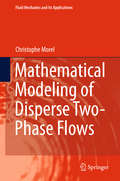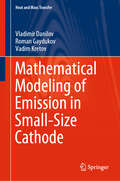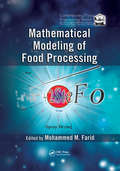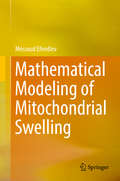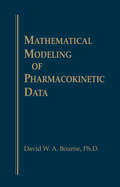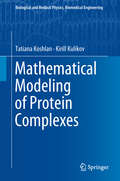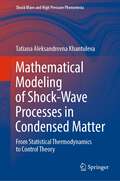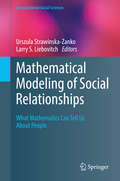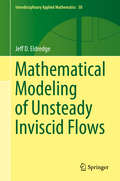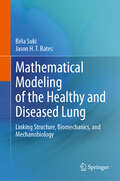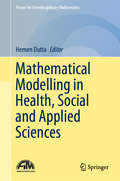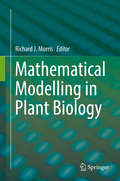- Table View
- List View
Mathematical Modeling and Numerical Techniques in Drying Technology
by Arun S. Mujumdar Ian TurnerOffers information necessary for the development of mathematical models and numerical techniques to solve specific drying problems. The book addresses difficult issues involved with the drying equations of numerical analysis, including mesh generation, discretinization strategies, the nonlinear equation set and the linearized algebraic system, convergance criteria, time step control, experimental validation, optimum methods of visualization results, and more.
Mathematical Modeling and Optimization of Complex Structures
by Pekka Neittaanmäki Tero Tuovinen Sergey RepinThis volume contains selected papers in three closely related areas: mathematical modeling in mechanics, numerical analysis, and optimization methods. The papers are based upon talks presented on the International Conference for Mathematical Modeling and Optimization in Mechanics, held in Jyväskylä, Finland, March 6-7, 2014 dedicated to Prof. N. Banichuk on the occasion of his 70th birthday. The articles are written by well-known scientists working in computational mechanics and in optimization of complicated technical models. Also, the volume contains papers discussing the historical development, the state of the art, new ideas, and open problems arising in modern continuum mechanics and applied optimization problems. Several papers are concerned with mathematical problems in numerical analysis, which are also closely related to important mechanical models. The main topics treated include: * Computer simulation methods in mechanics, physics, and biology; * Variational problems and methods; minimization algorithms; * Optimal control problems with distributed and discrete control; * Shape optimization and shape design problems in science and engineering; * Sensitivity analysis and parameters optimization of complex systems.
Mathematical Modeling and Scale-Up of Liquid Chromatography
by Tingyue GuTingyue Gu's second edition provides a comprehensive set of nonlinear multicomponent liquid chromatography (LC) models for various forms of LC, such as adsorption, size exclusion, ion-exchange, reversed-phase, affinity, isocratic/gradient elution and axial/radial flow LC. Much has advanced since the first edition of this book and the author's software, described here, is now used for teaching and research in 32 different countries. This book comes together with a complete software package with graphical user interface for personal computers, offered free for academic applications. Additionally, this book provides detailed methods for parameter estimation of mass transfer coefficients, bed voidage, particle porosity and isotherms. The author gives examples of how to use the software for predicitons and scale-up. In contrast to the first edition, authors do not need to deal with complicated math. Instead, they focus on how to obtain a few parameters for simulation and how to compare simulation results with experimental data. After reading the detailed descriptions in the book, a reader is able to use the simulation software to investigate chromatographic behavior without doing actual experiments. This book is aimed at readers who are interested in learning about LC behaviors and at those who want to scale up LC for preparative- and large-scale applications. Both academic personnel and industrial practitioners can benefit from the use of the book. This new edition includes: - New models and software for pellicular (cored) beads in liquid chromatography - Introduction of user-friendly software (with graphical user interface) - Detailed descriptions on how to use the software - Step-by-step instructions on parameter estimation for the models - New mass-transfer correlations for parameter estimation - Experimental methods for parameter estimation - Several actual examples using the model for product development and scale-up - Updated literature review
Mathematical Modeling and Validation in Physiology
by Mostafa Bachar Jerry J. Batzel Franz KappelThis volume synthesizes theoretical and practical aspects of both the mathematical and life science viewpoints needed for modeling of the cardiovascular-respiratory system specifically and physiological systems generally. Theoretical points include model design, model complexity and validation in the light of available data, as well as control theory approaches to feedback delay and Kalman filter applications to parameter identification. State of the art approaches using parameter sensitivity are discussed for enhancing model identifiability through joint analysis of model structure and data. Practical examples illustrate model development at various levels of complexity based on given physiological information. The sensitivity-based approaches for examining model identifiability are illustrated by means of specific modeling examples. The themes presented address the current problem of patient-specific model adaptation in the clinical setting, where data is typically limited.
Mathematical Modeling for Complex Fluids and Flows
by Michel Deville Thomas B. GatskiMathematical Modeling for Complex Fluids and Flows provides researchers and engineering practitioners encountering fluid flows with state-of-the-art knowledge in continuum concepts and associated fluid dynamics. In doing so it supplies the means to design mathematical models of these flows that adequately express the engineering physics involved. It exploits the implicit link between the turbulent flow of classical Newtonian fluids and the laminar and turbulent flow of non-Newtonian fluids such as those required in food processing and polymeric flows. The book develops a descriptive mathematical model articulated through continuum mechanics concepts for these non-Newtonian, viscoelastic fluids and turbulent flows. Each complex fluid and flow is examined in this continuum context as well as in combination with the turbulent flow of viscoelastic fluids. Some details are also explored via kinetic theory, especially viscoelastic fluids and their treatment with the Boltzmann equation. Both solution and modeling strategies for turbulent flows are laid out using continuum concepts, including a description of constructing polynomial representations and accounting for non-inertial and curvature effects. Ranging from fundamental concepts to practical methodology, and including discussion of emerging technologies, this book is ideal for those requiring a single-source assessment of current practice in this intricate yet vital field.
Mathematical Modeling for Genes to Collective Cell Dynamics (Theoretical Biology)
by Tetsuji TokihiroThis book describes the dynamics of biological cells and their mathematical modeling. The topics cover the dynamics of RNA polymerases in transcription, construction of vascular networks in angiogenesis, and synchronization of cardiomyocytes. Statistical analysis of single cell dynamics and classification of proteins by mathematical modeling are also presented. The book provides the most up-to-date information on both experimental results and mathematical models that can be used to analyze cellular dynamics. Novel experimental results and approaches to understand them will be appealing to the readers. Each chapter contains 1) an introductory description of the phenomenon, 2) explanations about the mathematical technique to analyze it, 3) new experimental results, 4) mathematical modeling and its application to the phenomenon. Elementary introductions for the biological phenomenon and mathematical approach to them are especially useful for beginners. The importance of collaboration between mathematics and biological sciences has been increasing and providing new outcomes. This book gives good examples of the fruitful collaboration between mathematics and biological sciences.
Mathematical Modeling in Biology: A Research Methods Approach (Chapman & Hall/CRC Mathematical Biology Series)
by Shandelle M. Henson James L. HaywardMathematical Modeling in Biology: A Research Methods Approach is a textbook written primarily for advanced mathematics and science undergraduate students and graduate-level biology students. Although the applications center on ecology, the expertise of the authors, the methodology can be imported to any other science, including social science and economics. The aim of the book, beyond being a useful aid to teaching and learning the core modeling skills needed for mathematical biology, is to encourage students to think deeply and clearly about the meaning of mathematics in science and to learn significant research methods. Most importantly, it is hoped that students will experience some of the excitement of doing research. Features Minimal pre-requisites beyond a solid background in calculus, such as a calculus I course. Suitable for upper division mathematics and sciences students and graduate-level biology students. Provides sample MATLAB codes and instruction in Appendices along with datasets available on https://bit.ly/3fcLF3D
Mathematical Modeling in Chemical Engineering
by Ronnie Andersson Bengt Andersson Anders Rasmuson Bengt Andersson Louise Olsson Anders Rasmuson Louise OlssonA solid introduction to mathematical modeling for a range of chemical engineering applications, covering model formulation, simplification and validation. It explains how to describe a physical/chemical reality in mathematical language and how to select the type and degree of sophistication for a model. Model reduction and approximation methods are presented, including dimensional analysis, time constant analysis and asymptotic methods. An overview of solution methods for typical classes of models is given. As final steps in model building, parameter estimation and model validation and assessment are discussed. The reader is given hands-on experience of formulating new models, reducing the models and validating the models. The authors assume the knowledge of basic chemical engineering, in particular transport phenomena, as well as basic mathematics, statistics and programming. The accompanying problems, tutorials, and projects include model formulation at different levels, analysis, parameter estimation and numerical solution.
Mathematical Modeling in Mechanics of Granular Materials
by Holm Altenbach Oxana Sadovskaya Vladimir SadovskiiThis monograph contains original results in the field of mathematical and numerical modeling of mechanical behavior of granular materials and materials with different strengths. It proposes new models helping to define zones of the strain localization. The book shows how to analyze processes of the propagation of elastic and elastic-plastic waves in loosened materials, and constructs models of mixed type, describing the flow of granular materials in the presence of quasi-static deformation zones. In a last part, the book studies a numerical realization of the models on multiprocessor computer systems. The book is intended for scientific researchers, lecturers of universities, post-graduates and senior students, who specialize in the field of the deformable materials mechanics, mathematical modeling and adjacent fields of applied and calculus mathematics.
Mathematical Modeling in Renal Physiology
by Anita T. Layton Aurélie EdwardsWith the availability of high speed computers and advances in computational techniques, the application of mathematical modeling to biological systems is expanding. This comprehensive and richly illustrated volume provides up-to-date, wide-ranging material on the mathematical modeling of kidney physiology, including clinical data analysis and practice exercises. Basic concepts and modeling techniques introduced in this volume can be applied to other areas (or organs) of physiology. The models presented describe the main homeostatic functions performed by the kidney, including blood filtration, excretion of water and salt, maintenance of electrolyte balance and regulation of blood pressure. Each chapter includes an introduction to the basic relevant physiology, a derivation of the essential conservation equations and then a discussion of a series of mathematical models, with increasing level of complexity. This volume will be of interest to biological and mathematical scientists, as well as physiologists and nephrologists, who would like an introduction to mathematical techniques that can be applied to renal transport and function. The material is written for students who have had college-level calculus, but can be used in modeling courses in applied mathematics at all levels through early graduate courses.
Mathematical Modeling of Biological Processes
by Avner Friedman Chiu-Yen KaoThis book on mathematical modeling of biological processes includes a wide selection of biological topics that demonstrate the power of mathematics and computational codes in setting up biological processes with a rigorous and predictive framework Topics include: enzyme dynamics, spread of disease, harvesting bacteria, competition among live species, neuronal oscillations, transport of neurofilaments in axon, cancer and cancer therapy, and granulomas. Complete with a description of the biological background and biological question that requires the use of mathematics, this book is developed for graduate students and advanced undergraduate students with only basic knowledge of ordinary differential equations and partial differential equations; background in biology is not required. Students will gain knowledge on how to program with MATLAB without previous programming experience and how to use codes in order to test biological hypothesis.
Mathematical Modeling of Biosensors
by Juozas Kulys Romas Baronas Feliksas IvanauskasThis book presents biosensor development and modeling from both a chemical and a mathematical point of view. It contains unique modeling methods for catalytical (amperometric, potentiometer and optical) biosensors. It examines processes that occur in the sensors' layers and at their interface, and it provides analytical and numerical methods to solve enzymatic kinetic and diffusion equations. The action of single enzyme as well as polyenzyme biosensors is studied, and the modeling of biosensors that contain perforated membranes and multipart mass transport profiles is critically investigated. Furthermore, it is fully described how signals can be biochemically amplified, how cascades of enzymatic substrate conversion are triggered, and how signals are processed via a chemometric approach and artificial neuronal networks. The results of digital modeling are compared with both proximal analytical solutions and experimental data.
Mathematical Modeling of Biosensors: An Introduction For Chemists And Mathematicians (Springer Series on Chemical Sensors and Biosensors #9)
by Juozas Kulys Romas Baronas Feliksas IvanauskasThis newly designed and enlarged edition offers an up-to-date presentation of biosensor development and modeling from both a chemical and a mathematical point of view. An entire new chapter in particular is dedicated to optimal design of biosensors. Two more new chapters discuss biosensors which utilize microbial cells and are based on carbon nanotubes respectively. All the other chapters have been revised and updated. The book contains unique modeling methods for amperometric, potentiometric and optical biosensors based mainly on biocatalysts . It examines processes that occur in the sensors' layers and at their interface, and it provides analytical and numerical methods to solve equations of conjugated enzymatic (chemical) and diffusion processes. The action of single enzyme as well as polyenzyme biosensors and biosensors based on chemically modified electrodes is studied. The modeling of biosensors that contain perforated membranes and multipart mass transport profiles is critically investigated. Furthermore, it is fully described how signals can be biochemically amplified, how cascades of enzymatic substrate conversion are triggered, and how signals are processed via a chemometric approach and artificial neuronal networks. The results of digital modeling are compared with both proximal analytical solutions and experimental data.
Mathematical Modeling of Disperse Two-Phase Flows
by Christophe MorelThis book develops the theoretical foundations of disperse two-phase flows, which are characterized by the existence of bubbles, droplets or solid particles finely dispersed in a carrier fluid, which can be a liquid or a gas. Chapters clarify many difficult subjects, including modeling of the interfacial area concentration. Basic knowledge of the subjects treated in this book is essential to practitioners of Computational Fluid Dynamics for two-phase flows in a variety of industrial and environmental settings. The author provides a complete derivation of the basic equations, followed by more advanced subjects like turbulence equations for the two phases (continuous and disperse) and multi-size particulate flow modeling. As well as theoretical material, readers will discover chapters concerned with closure relations and numerical issues. Many physical models are presented, covering key subjects including heat and mass transfers between phases, interfacial forces and fluid particles coalescence and breakup, amongst others. This book is highly suitable for students in the subject area, but may also be a useful reference text for more advanced scientists and engineers.
Mathematical Modeling of Emission in Small-Size Cathode (Heat and Mass Transfer)
by Vladimir Danilov Roman Gaydukov Vadim KretovThis book deals with mathematical modeling, namely, it describes the mathematical model of heat transfer in a silicon cathode of small (nano) dimensions with the possibility of partial melting taken into account. This mathematical model is based on the phase field system, i.e., on a contemporary generalization of Stefan-type free boundary problems. The approach used is not purely mathematical but is based on the understanding of the solution structure (construction and study of asymptotic solutions) and computer calculations. The book presents an algorithm for numerical solution of the equations of the mathematical model including its parallel implementation. The results of numerical simulation concludes the book. The book is intended for specialists in the field of heat transfer and field emission processes and can be useful for senior students and postgraduates.
Mathematical Modeling of Food Processing
by Mohammed M. FaridWritten by international experts from industry, research centers, and academia, Mathematical Modeling of Food Processing discusses the physical and mathematical analysis of transport phenomena associated with food processing. The models presented describe many of the important physical and biological transformations that occur in food during proces
Mathematical Modeling of Mitochondrial Swelling
by Messoud EfendievThe mathematical models considered in this book can help to understand the swelling of mitochondria. For the first time, it presents new mathematical models of mitochondrial swelling that take into account, in particular, spatial effects. The results presented here could make it possible to predict properties of the underlying biological mechanisms. Taking into account that mitochondria could move within a cell, lead to a PDE-PDE model. The book discusses the well-posedness and long-term dynamics of solutions, depending on boundary conditions reflecting the in vitro and in vivo cases. These analytical and numerical results have inspired colleagues from the Institute of Pharmacology and Toxicology of the Helmholtz Center Munich to design new experiments justifying the theoretical and numerical results that are obtained. The book is intended for graduates students and researchers with a solid mathematical background and an interest in cell biology.
Mathematical Modeling of Pharmacokinetic Data
by DavidW.A. BourneA concise guide to mathematical modeling and analysis of pharmacokinetic data, this book contains valuable methods for maximizing the information obtained from given data. It is an ideal resource for scientists, scholars, and advanced students.
Mathematical Modeling of Protein Complexes (Biological and Medical Physics, Biomedical Engineering)
by Kirill Kulikov Tatiana KoshlanThis book is devoted to the physical and mathematical modeling of the formation of complexes of protein molecules. The models developed show remarkable sensitivity to the amino acid sequences of proteins, which facilitates experimental studies and allows one to reduce the associated costs by reducing the number of measurements required according to the developed criteria. These models make it possible to reach a conclusion about the interactions between different amino acid chains and to identify more stable sites on proteins. The models also take the phosphorylation of amino acid residues into account. At the end of the book, the authors present possible directions of application of their physical and mathematical models in clinical medicine.
Mathematical Modeling of Shock-Wave Processes in Condensed Matter: From Statistical Thermodynamics to Control Theory (Shock Wave and High Pressure Phenomena)
by Tatiana Aleksandrovna KhantulevaThis book offers an interdisciplinary theoretical approach based on non-equilibrium statistical thermodynamics and control theory for mathematically modeling shock-induced out-of-equilibrium processes in condensed matter. The book comprises two parts. The first half of the book establishes the theoretical approach, reviewing fundamentals of non-equilibrium statistical thermodynamics and control theory of adaptive systems. The latter half applies the presented approach to a problem on shock-induced plane wave propagation in condensed matter. The result successfully reproduces the observed feature of waveform propagation in experiments, which conventional continuous mechanics cannot access. Further, the consequent stress–strain relationships derived with relaxation and inertia effect in elastic–plastic transition determines material properties in transient regimes.
Mathematical Modeling of Social Relationships: What Mathematics Can Tell Us About People (Computational Social Sciences)
by Larry S. Liebovitch Urszula Strawinska-ZankoThis edited volume presents examples of social science research projects that employ new methods of quantitative analysis and mathematical modeling of social processes. This book presents the fascinating areas of empirical and theoretical investigations that use formal mathematics in a way that is accessible for individuals lacking extensive expertise but still desiring to expand their scope of research methodology and add to their data analysis toolbox. Mathematical Modeling of Social Relationships professes how mathematical modeling can help us understand the fundamental, compelling, and yet sometimes complicated concepts that arise in the social sciences. This volume will appeal to upper-level students and researchers in a broad area of fields within the social sciences, as well as the disciplines of social psychology, complex systems, and applied mathematics.
Mathematical Modeling of Unsteady Inviscid Flows (Interdisciplinary Applied Mathematics #50)
by Jeff D. EldredgeThis book builds inviscid flow analysis from an undergraduate-level treatment of potential flow to the level required for research. The tools covered in this book allow the reader to develop physics-based mathematical models for a variety of flows, including attached and separated flows past wings, fins, and blades of various shapes undergoing arbitrary motions. The book covers all of the ingredients of these models: the solution of potential flows about arbitrary body shapes in two- and three-dimensional contexts, with a particular focus on conformal mapping in the plane; the decomposition of the flow into contributions from ambient vorticity and body motion; generalized edge conditions, of which the Kutta condition is a special case; and the calculation of force and moment, with extensive treatments of added mass and the influence of fluid vorticity. The book also contains an extensive primer with all of the necessary mathematical tools. The concepts are demonstrated on several example problems, both classical and modern.
Mathematical Modeling of the Healthy and Diseased Lung: Linking Structure, Biomechanics, and Mechanobiology
by Béla Suki Jason H. BatesThe lung is a complex multiscale organ that serves as the primary interface between the environment and the tissues of the body. Homeostatic maintenance of lung function throughout life is essential for health. While failure of lung homeostasis underlies many of the most common chronic diseases that afflict mankind, the precise pathophysiologic mechanisms involved are often unclear. Investigative techniques such as microscopic imaging and atomic force microscopy are providing new insights into lung tissue properties at the micro scale. It nevertheless remains to be seen how this growing body of information can be integrated into a comprehensive picture of the lung. Mathematical and computational modeling has emerged as an essential tool for gaining such a holistic understanding. This book introduces the reader to the art of modeling as a means of linking lung structure to function over multiple length scales from the intracellular level to that of the whole organ, with specific attention given to the pathophysiology of a number of common lung diseases and aging.
Mathematical Modelling in Health, Social and Applied Sciences (Forum for Interdisciplinary Mathematics)
by Hemen DuttaThis book discusses significant research findings in the field of mathematical modelling, with particular emphasis on important applied-sciences, health, and social issues. It includes topics such as model on viral immunology, stochastic models for the dynamics of influenza, model describing the transmission of dengue, model for human papillomavirus (HPV) infection, prostate cancer model, realization of economic growth by goal programming, modelling of grazing periodic solutions in discontinuous systems, modelling of predation system, fractional epidemiological model for computer viruses, and nonlinear ecological models. A unique addition in the proposed areas of research and education, this book is a valuable resource for graduate students, researchers and educators associated with the study of mathematical modelling of health, social and applied-sciences issues. Readers interested in applied mathematics should also find this book valuable.
Mathematical Modelling in Plant Biology
by Richard J. MorrisProgress in plant biology relies on the quantification, analysis and mathematical modeling of data over different time and length scales. This book describes common mathematical and computational approaches as well as some carefully chosen case studies that demonstrate the use of these techniques to solve problems at the forefront of plant biology. Each chapter is written by an expert in field with the goal of conveying concepts whilst at the same time providing sufficient background and links to available software for readers to rapidly build their own models and run their own simulations. This book is aimed at postgraduate students and researchers working the field of plant systems biology and synthetic biology, but will also be a useful reference for anyone wanting to get into quantitative plant biology.
